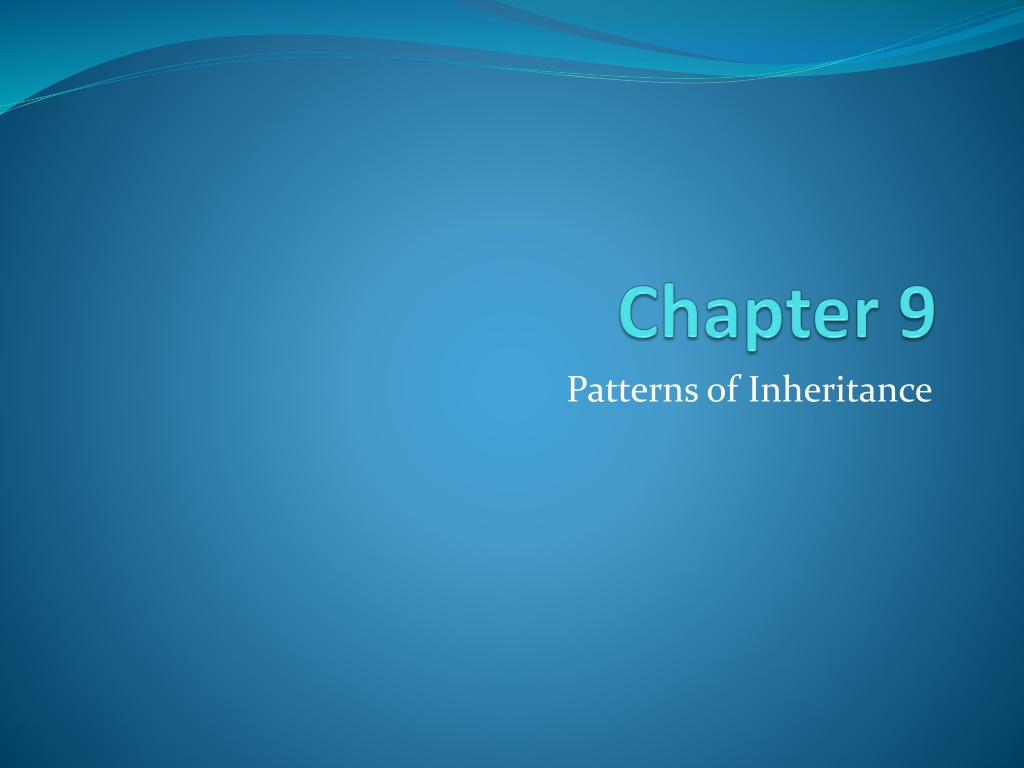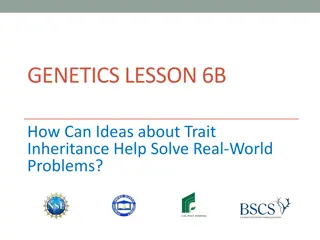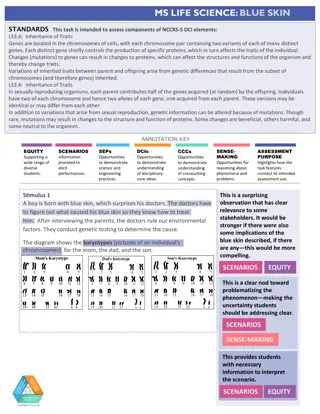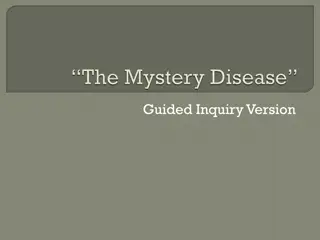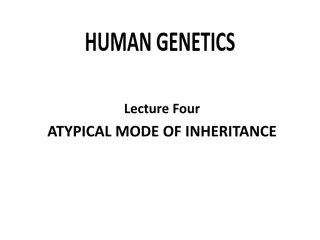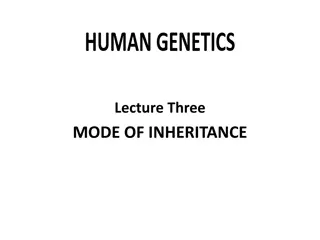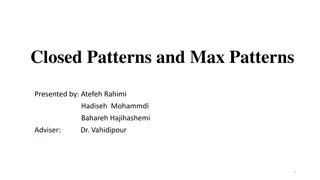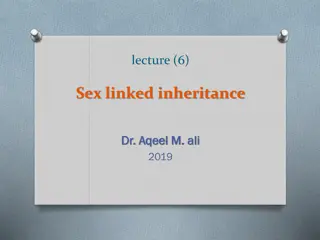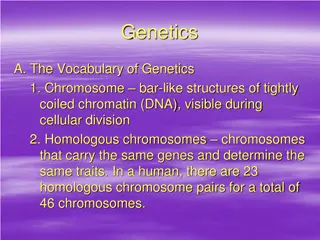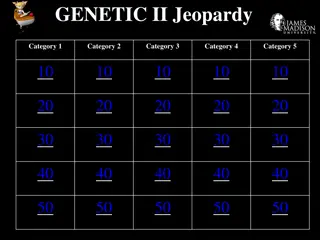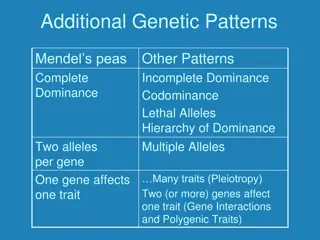Understanding Patterns of Inheritance and Genetic Disorders
Explore the fascinating world of patterns of inheritance through pedigrees, analyzing traits in humans, and understanding disorders determined by single genes. Delve into autosomal recessive diseases, autosomal dominant disorders, Mendel's assumptions, and exceptions to those assumptions. Discover probabilities of genetic outcomes in different scenarios and learn about multiple alleles, blending, co-dominance, and more complexities in genetics.
Download Presentation

Please find below an Image/Link to download the presentation.
The content on the website is provided AS IS for your information and personal use only. It may not be sold, licensed, or shared on other websites without obtaining consent from the author. Download presentation by click this link. If you encounter any issues during the download, it is possible that the publisher has removed the file from their server.
E N D
Presentation Transcript
9.8 Pedigree analysis A pedigree can be used to analyze traits in humans
9.9 Disorders determined by a single gene AUTOSOMAL RECESSIVE DISEASES Albinism Cystic fibrosis PKU (phenylketonuria) Sickle cell disease Tay- Sachs disease
Practice problem Mary and Steve have a child with cystic fibrosis but neither of them have the disease. What are the chances that their next child will have cystic fibrosis? Ann is a carrier for sickle cell anemia. Her husband is not a carrier. Neither has any symptoms of the disease. What are the chances that their children will have sickle cell anemia?
Autosomal dominant disorders Achondroplasia Huntingdon s disease Problems Peter s father has Huntingdon s disease. His mother does not. Peter s much older sister also does not have the disease. What are the chances that Peter has Huntingdon s disease?
Problems Alicia and Phil are both achondroplasics. What are the chances that they will have a normal stature child? What are the chances they will have a child with achondroplasia?
Mendel's assumptions All traits are determined by two alleles (or one pair of genes) There are two possible genes or alleles for that trait One gene is completely dominant to the other. One gene pair determines one trait Genes for different traits independently assort (or one gene per chromosome)
Exceptions to Mendels assumptions Multiple alleles- traits may be determined by more than two alleles- blood type Blending and incomplete dominance- genes may not be completely dominant hair texture Co-dominance both alleles contribute to phenotype and do not interfere with each other blood type Linkage genes on same chromosome are inherited together (sex linkage) Epistasis/polygenic inheritance- one trait determined by more than one gene pair skin color Pleiotropy- one gene has multiple effects sickle cell
9.12 Blending/Incomplete Dominance Heterozygous individuals are a blend of two alleles. For example crossing a red and a white flower generates all pink flowers. Cross two pink flowers.
Incomplete dominance Cross two snapdragon plants that are heterozygous for pink flowers and tall height. Tall and red are dominant traits.
9.13 Blood type alleles Three alleles for blood type: A, B, o Also written IA, IB, Io A and B are codominant, both are dominant to o What are the possible combinations of the two alleles for blood type? How many blood types exist?
Blood type problems A woman has blood type B and her husband has blood type A. They have a baby with blood type O. What other blood types are possible in their future children?
Blood type and paternity A woman with Type O blood has a baby with Type B blood. Two men claim responsibility for the child. Man #1 has blood type A. Man #2 has blood type AB. Who cannot be the child s father?
9.14 Pleiotropy One allele can have many phenotypic effects
9.15 One trait controlled by multiple gene pairs Polygenic inheritance Epistasis
Epistasis problem In corn the dominant allele (I) creates colorless kernels while the recessive allele (i) allows color to be deposited. At a different gene locus the domina t gene (P) creates purple kernels, while the recessive gene (p) creates red kernels. What is the color of each kernel? IiPp Iipp iiPp
Problems Cross two corn plants heterozygous for both genes
Sex linkage Sex linked genes are on X chromosome and have nothing to do with gender Females inherit two copies of the gene Males only inherit one they only have one X Sex linked recessive diseases are more common in males
Sex Linkage Problems Color blindness is a sex linked recessive disease. A woman whose father was color blind marries a normal man. Find the phenotypic ratios in their children A hemophiliac man and a normal woman marry and have children. What percentage of their children will also have hemophilia?
Sex- Linkage problems Fur color in cats is sex linked. Two co -dominant alleles for fur color exist in tabby cats, orange and black. Tortoise shell cats have both alleles. Cross a black female with an orange male Cross a tortoise shell female with a black male Are there ever any male tortoise shell cats?
Hemophilia Lack a blood clotting protein Royal disease- Queen Victoria was a carrier. Victoria s daughters spread the disease to other European royal families through marriage. Alexis who was the son of the last czar of Russia was terribly afflicted. His parents preoccupation with his illness was a factor in the Russian revolution
Hemophilia Little to no treatment before the 1950s- Crutches and wheelchairs for protection, risk of major tissue damage from bleeds Doctors isolated the missing clotting protein and are able to collect it from donated blood. All blood is tested for infectious disease because of a highly publicized hemophiliac named Ryan White who died of AIDS from a transfusion
Duchenne Muscular dystrophy Untreatable progressive muscle wasting disease Fatal usually in early 20s due to impairment of heart and breathing muscles
